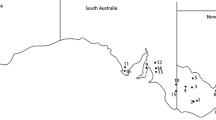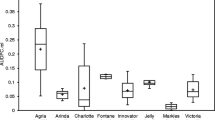Abstract
Onion downy mildew (Dm) symptoms and damage on seed production fields in southern Uruguay were quantified during two seasons as the progress of incidence, severity, and as the effect of the level of seed-stalks infections on seed yield and quality. In addition, the effects of two plantation dates and two plant densities on Dm were studied in a factorial experiment. Maximum incidence along the season ranged from 15 to 65% in four commercial fields in 2005 and two fields in 2006. Maximum severity ranged from 4.5 to 9.3% of leaf area affected in 2005, and 0.35 to 1.17% in 2006. Whereas Dm incidence varied among studied fields, disease progress as Dm severity varied mainly between studied years. Crop rotation, crop vigour and plant density were identified as major factors affecting Dm variation in the field. Intensive fungicide schedules did not control Dm when other conditions favoured the disease. A high level of Dm severity defined as large necklace spots on seed-stalks significantly reduced seed yield in comparison with healthy seed-stalks in 2005, as well as seed yield and germination in 2006. Weight of 1,000 seeds was not significantly reduced by Dm infections on seed-stalks. Six genera of fungi were recovered from seeds harvested on highly infected seed-stalks (Stemphylium, Fusarium, Alternaria, Penicillium, Aspergillus and Botrytis), but not Peronospora. Late planting date and low plant density had significantly lower Dm incidence and severity. This finding questioned the early planting dates and high densities previously recommended in order to achieve high yielding crops. The combination of several practices to reduce initial inoculum, susceptibility status of the host, and environmental conditions promoting the disease is discussed as forming a basis for effective disease control.



Similar content being viewed by others
References
Arboleya, J. E., Villamil, J. M., & Itoh, M. (1987). Efecto de la fecha de plantación de bulbos de cebolla sobre el rendimiento y la calidad de la semilla. Horticultura Argentina, 6, 49–65.
Box, G. E. P., Hunter, W. G., & Hunter, J. S. (1978). Statistics for experimenters: An introduction to design, data analysisi and model building. New York: Wiley Interscience. 653p.
C. M. I. (1990). Distribution maps of plant diseases, Map Nr. 76, Onion downy mildew. Kew, Surrey, United Kingdom.
Cardani, A., Giménez, G., & Verdier, E. (1990). Calidad de semilla de cebolla (Allium cepa L.). Montevideo: Tesis Ing. Agr. Facultad de Agronomía, Universidad de la República.
Colnago, P. (2009). Evaluación de la respuesta a Peronospora destructor (Berk.) Casp. en el germoplasma local de cebolla. Tesis M. Sc. Facultad de Agronomía, Universidad de la República. Montevideo, Uruguay.
Ellerbrock, L. A., & Lorbeer, J. W. (1977). Sources of primary inoculum of Botrytis squamosa. Phytopathology, 67, 363–372.
Galván, G., González, H., & Sollier, S. (1997). Productive adaptation of onion (Allium cepa L) landraces used for post-harvest storage. Acta Horticulturae, 433, 165–170.
Galván, G., González, H., & Vilaró, F. (2005). Estado actual de la investigación en poblaciones locales de hortalizas en Uruguay y su utilización en el mejoramiento. Agrociencia, 9, 115–122.
Gilles, T., Phelps, K., Clarkson, J. P., & Kennedy, R. (2004). Development of MILIONCAST, an improved model for predicting downy mildew sporulation on onions. Plant Disease, 88, 695–702.
González, H., Peluffo, S., & Galván, G. (2007). Caracterización del Programa de Producción de semilla certificada del cultivar de cebolla “Pantanoso del Sauce CRS” (abstract). Congreso Nacional de Horti-Fruticultura, 11th. Montevideo, Uruguay.
Hilderbrand, P. D., & Sutton, J. C. (1982). Weather variables in relation to an epidemic of onion downy mildew. Phytopathology, 72, 219–224.
ISTA. (1976). International rules for seed testing. International Seed Testing Association. Seed Science and Technology, 4, 3–177.
Kennedy, R., & Wakeham, A. J. (2008). Development of detection systems for the sporangia of Peronospora destructor. European Journal of Plant Pathology, 122, 147–155.
Kofoet, A., & Zinkernagel, V. (1989). Resistance to downy mildew (Peronospora destructor (Berk.) Casp.) in Allium species. Journal of Plant Diseases and Protection, 97, 13–23.
Leach, C. M., Hilderbrand, P. D., & Sutton, J. C. (1982). Sporangium discharge by Peronospora destructor: influence of humidity, red-infrared radiation and vibration. Phytopathology, 72, 1052–1056.
Lorbeer, J. W., Kuhar T. P., & Hoffmann M. P. (2002). Monitoring and forecasting for disease and insect attack in onions and Allium crops within IPM strategies. InH. D. Rabinowitch & L. Currah (Ed.), Allium crop science: recent advances (pp. 293–310). CABI Publishing.
Maeso, D. (2005). Enfermedades del cultivo de cebolla. In J. Arboleya (Ed.), Tecnología para la producción de cebolla. INIA Boletín de divulgación 88, Uruguay, pp. 151–188.
Maude, R. B. (1990). Leaf diseases of onions. In H. D. Rabinowitch & J. L. Brewster (Eds.), Onion and allied crops (pp. 173–212). Boca Raton: CRC.
MGAP, DIEA-DIGEGRA. (2006). Encuesta Hortícola Zonas Sur y Litoral Norte año 2006. Montevideo, Uruguay.
Özer, N., & Köycü, N. D. (2004). Seed-borne fungal diseases of onion and their control. In K. G. Mukerji (Ed.), Disease management of fruits and vegetables (pp. 281–306). Dordrecht-Boston-London: Kluver Academic.
Palti, J. (1989). Epidemiology, prediction and control of onion downy mildew caused by Peronospora destructor. Phytoparasitica, 17, 31–48.
Rondomanski, W. (1971). The sources of primary infection of onion downy mildew (Peronospora destructor (Berk.) Fries). Tagunsbericht Deutsche Akademie der Landwirtschaftswissenschaften zu Berlin, 115, 157–171.
Rudolph, M. (1990). On disease infection in onion seed plants (Allium cepa L.). Nachrichtenblatt Pflanzenschutz, 44, 180–182.
Scholten, O. E., Van Heusden, A. W., Khrustaleva, L. I., Burger-Meijer, K., Mank, R. A., Antonise, R. G. C., et al. (2007). The long and winding road leading to the successful introgression of downy mildew resistance into onion. Euphytica, 156, 345–353.
Schwartz, H. F., & Mohan, S. K. (2008). Compendium of onion and garlic diseases. St. Paul: APS. 127p.
Scott, J. B., Hay, F. S., & Wilson, C. R. (2004). Phylogenetic analysis of the downy mildew pathogen of oilseed poppy in Tasmania, and its detection by PCR. Mycological Research, 108, 198–205.
Sharma, R. C., Gill, S. S., & Kohli, N. (2002). Pathological problems in production and storage of onion seed in Punjab and their remedial measures. Seed Research, 30, 134–141.
Sutton, J. C. (1986). Forecasting onion diseases: a key to efficient fungicide use. Highlights, 9, 13–16.
Tsay, J. G., Chu, C., Chuang, Y. H., & Chen, R. S. (2006). Specific detection of Peronospora tabacina by PCR-amplified rDNA sequences. Plant Pathology Journal, 5, 378–382.
Van Doorn, A. M. (1959). Onderzoekingen over het optreden en de bestrijding van valse meeldauw (Peronospora destructor) bij uien. Tijdschriven Plantenziekten, 65, 193–255.
Verona, L. A. F., Pacheco, A. C., Zanini Neto, J. A., Gandin, C. L., & Thomazelli, L. F. (1996). Qualidade e produtividade de sementes de cebola na regiao Oeste Catarinense - safra 1994/95. Agropecuaria Catarinense, 9, 29–32.
Vilaró, F., Vicente, E., Pereyra, G., & Rodríguez, G. (2005). Cultivares y mejoramiento genético en cebolla. In J. Arboleya (Ed.), Tecnología para la producción de cebolla. INIA, Uruguay. Boletín de Divulgación 88. pp. 31–42.
Virányi, F. (1974). Studies on the biology and ecology of onion downy mildew (Peronospora destructor (Berk.) Fries) in Hungary. I. Onverwintering of the pathogen in onion bulbs. Acta Phylopathologica Academiae Scientiarum Hungaricae, 9, 3–4.
Virányi, F. (1981). Downy mildew of onion. In D. M. Spencer (Ed.), The downy mildews (pp. 463–472). Littlehampton: Academic.
Acknowledgements
This research was part of a Project coordinated by H. González Idiarte and founded by CSIC-SP, Universidad de la República, Uruguay. We thank onion seed-growers belonging to CALSESUR who kindly contributed to the surveys and experiments for this research. Thanks are due also to O. Costa, N. Curbelo, V. Ferreira, and N. Jara for their technical assistance during installation and evaluation of field experiments and seed quality tests.
Author information
Authors and Affiliations
Corresponding author
Rights and permissions
About this article
Cite this article
González, P.H., Colnago, P., Peluffo, S. et al. Quantitative studies on downy mildew (Peronospora destructor Berk. Casp.) affecting onion seed production in southern Uruguay. Eur J Plant Pathol 129, 303–314 (2011). https://doi.org/10.1007/s10658-010-9697-7
Accepted:
Published:
Issue Date:
DOI: https://doi.org/10.1007/s10658-010-9697-7




